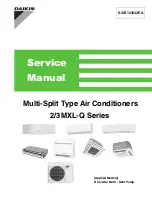
Sevice guide | Application, Installation and Maintenance Manual MCHE
4 |
AX292455807588en-000101 | 01.2019
2.
Storage and working
environments
•
Microchannel heat exchangers should be
stored indoors in a dry and clean environ-
ment .
•
The storage temperature range is -40 °C to
121°C (-40°F to 250°F) .
•
Metal chips, and/or copper or steel dust can
cause galvanic corrosion, so storage and
installation areas must remain clean and
separate from machining or welding areas .
Use separate tools and/or keep tools clean .
•
To minimize potential damage, we recom-
mend that you keep MCHEs in their original
packaging until they are installed in the air
conditioning or refrigeration equipment .
•
Improper storage and stacking of MCHEs
can cause premature corrosion or deforma-
tion and will reduce MCHE’s life . Extra care
should be taken when storing MCHEs!
•
Refrigerants used in MCHE shall comply with
AHRI Standard 700 .
•
The maximum operating pressure shall not
exceed the value shown on the Label of
MCHE .
2.1 Storage
2.2 Handling
Compared to tube & fin coils, microchannel heat
exchangers are relatively light, the fins are harder
to bend and they are less likely to cut fingers . The
combination of these features makes MCHEs
easier to handle than tube & fin coils . However,
the overall coil assembly is made of soft alu-
minum, so it is susceptible to deformation (Fig .1)
Do not lift MCHX in
inlet/outlet pipes
Fig . 1 Handling attentions
2.3 Bending procedure
The same bending machines can be used for
MCHE and tube & fin heat exchangers . In order to
optimize costs associated with shipping and
packaging, we recommend that MCHEs be
shipped flat and formed at the customer’s
location .
Bending Radius:
The minimum bend radius required to achieve
acceptable manufacturing yields is a function of
the microchannel tube, fin, and alloy, the overall
capabilities of the bending equipment including,
fixturing, bending speed and bending length .
NOTE: Conducting trial bending runs of the
specific coil and configuration are recommended
to verify . In general, tighter radius, thicker tubes
and longer bend lines are harder to bend . Use a
larger radius if possible .
Recommended minimum bending radii (as
determined by factory tests under favorable
conditions) are shown in Table 1 for different
microchannel tubes and fins . Consult with
Danfoss for the tubes not listed . Do not
arbitrarily extrapolate or interpolate the values .
•
Never lift a MCHE by the inlet and outlet
tubes as it might result in dimensional
deviation or worse yet, the initiation of a
crack that can later result in a leak .
•
Do not hit or drop MCHE on edges .
The MCHE is constructed of soft aluminum
therefore, dropping, striking, placing heavy
objects on top of, or stepping on any part of the
heat exchanger will likely cause a deformation . If
the coil becomes slightly deformed or bowed, it
is possible to flatten them back out by laying
them concave side down on a flat hard surface
and applying pressure via a large heavy flat plate
(say 3-4 square feet of ½” non-metallic sheet,
such as plywood or plastic, with a couple of
handles attached) . This procedure works for
bowed coils with flush fins, but not for local fin
protrusions .
MC
Tube
Structural parameters
Material
Min . recommended bending R
Tube
(Wmm*Hmm*Port#)
Fin
(Hmm*Gage mm)
mm
in
C116
16*1 .3*16
8 .1*0 .08
3102
Tube
+
3003MOD
Fin
90
3 .5
C120
20 .6*1 .3*20
140
5 .5
C125
25 .4*1 .3*26
200
7 .87
Table 1




























